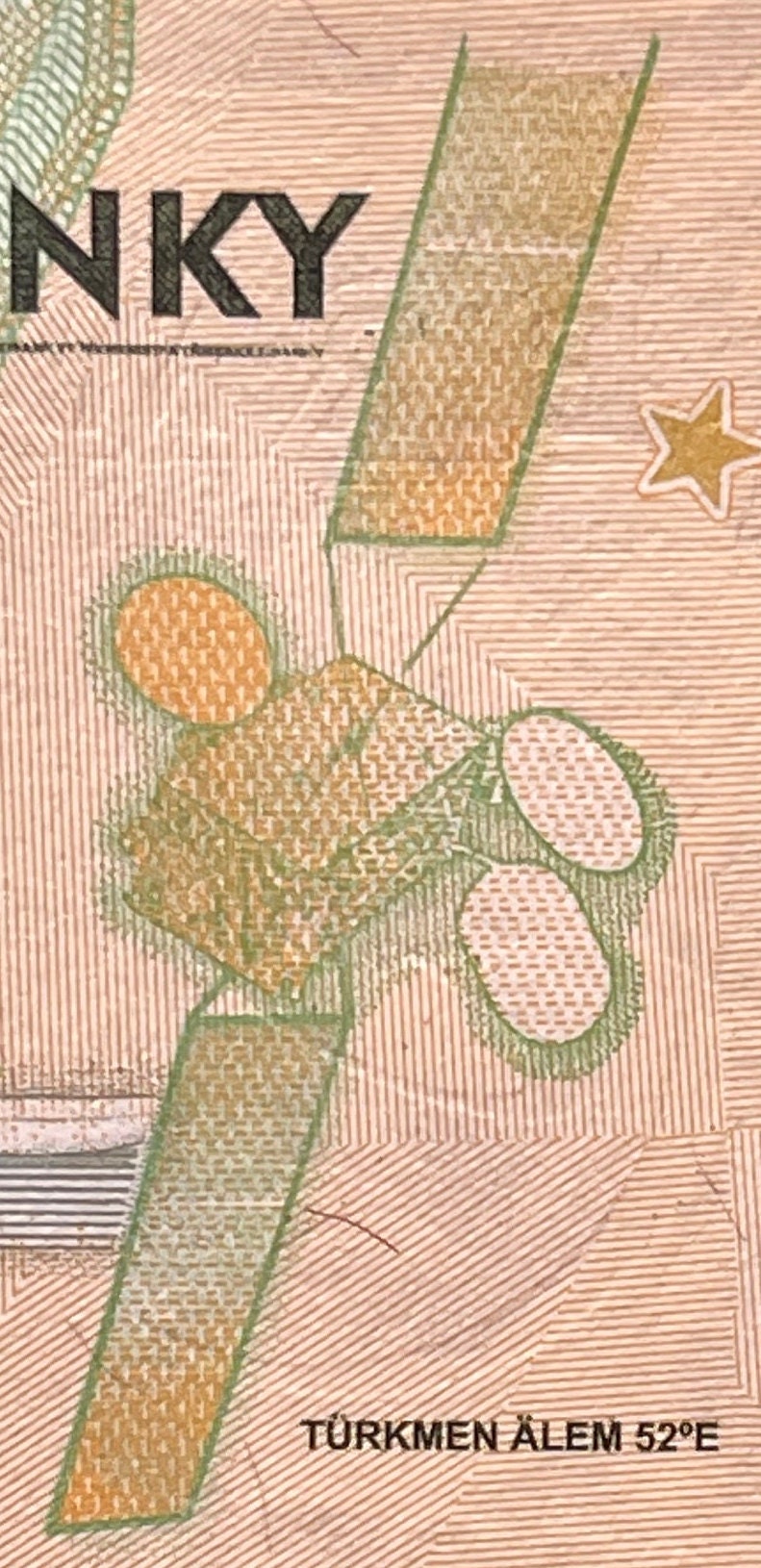elemintalshop
Seljuk Empire Founder Tughril & Falcon-Shaped Airport 1 Manat Turkmenistan Authentic Banknote Money for Collage (Aşgabat Airport) Satellite
Seljuk Empire Founder Tughril & Falcon-Shaped Airport 1 Manat Turkmenistan Authentic Banknote Money for Collage (Aşgabat Airport) Satellite
Couldn't load pickup availability
Seljuk Empire Founder Tughril & Falcon-Shaped Airport 1 Manat Turkmenistan Authentic Banknote Money for Jewelry and Collage (Aşgabat International Airport) (Satellite)
Commemorative issue: 5th Asian Indoor and Martial Games
Obverse: Tughril at right (aka Togrul Beg Türkmen).
Coat of arms.
Map of Turkmenistan.
Commemoration motif for 5th Asian Indoor and Martial Games at left.
Lettering: BIR MANAT
TÜRKMENISTANYŇ MERKEZI BANKY
ŞU BANKNOT TÖLEGLERIŇ ÄHLI GÖRNÜŞLERI ÜÇIN ÝÖREÝÄR
Translation: One Manat, Central Bank of Turkmenistan, This banknote is valid for all types of payments
Reverse: Aşgabat halkara howa menzili (New International Airport of Aşgabat), featuring a highly unusual terminal design in the shape of a falcon.
Also, Turkmenistan's first satellite TürkmenÄlem 52°E
Also: A waxing crescent moon of white, typical of Turkic symbology, and five five-pointed stars also of white. The waxing crescent moon symbolizes the hope of the country for a shining future and the stars represent the five provinces (welayatlar) of Turkmenistan-Ahal, Balkan, Dashoguz, Lebap, and Mary.
Lettering: TÜRKMENISTANYŇ MERKEZI BANKY
XXI ASYR – TÜRKMENIŇ ALTYN ASYRY
BIR MANAT
Translation: Central Bank of Turkmenistan, The 21st century is the golden age of the Turkmen, One Manat
Watermark: Tughril (aka Togrul Beg Türkmen), Crescent moon with five five-pointed stars, numeral 1
Features
Issuer Turkmenistan
Issuing bank Central Bank of Turkmenistan
Period Republic (1991-date)
Type Commemorative note
Year 2017
Value 1 Manat
1 TMT = USD 0.29
Currency New manat (2009-date)
Composition Paper
Size 120 × 60 mm
Shape Rectangular
Number N# 204005
References P# 36
Wikipedia:
Abu Talib Muhammad Tughril ibn Mika'il (Persian: ابوطالب محمد تغریل بن میکائیل), better known as Tughril (طغریل; also spelled Toghril), was a Turkoman chieftain, who founded the Seljuk Empire, ruling from 1037 to 1063.
He united many Turkmen warriors of the Central Asian steppes into a confederacy of tribes, who traced their ancestry to a single ancestor named Seljuk, and led them in conquest of eastern Iran. He would later establish the Seljuk Sultanate after conquering Iran and taking the Abbasid capital of Baghdad from the Buyids in 1055. Tughril relegated the Abbasid Caliphs to state figureheads and took command of the caliphate's armies in military offensives against the Byzantine Empire and the Fatimids in an effort to expand his empire's borders and unite the Islamic world.
Before the advent of the Seljuks, Iran was divided between several warring local powers, such as the Saffarids, Buyids, Kakuyids, and Ghaznavids. As a result, it suffered from continuous war and destruction. However, under Tughril peace and prosperity were brought to the country and to Mesopotamia, a transition that was further reinforced due to the Seljuks' assimilation to Iranian-Muslim culture.
*******
Wikipedia:
Ashgabat International Airport (Turkmen: Aşgabat halkara howa menzili) (IATA: ASB, ICAO: UTAA), formerly known as Saparmyrat Türkmenbaşy International Airport, is one of five international airports in Turkmenistan.
New building (2016)
The Turkmen government let an international tender in 2012 for reconstruction of the airport in Ashgabat, to be named "Oguz Han". Polimeks, a Turkish construction company active in Turkmenistan since the late-1990s, was declared winner of the tender. The new airport was opened on 17 September 2016 by President Gurbanguly Berdimuhamedow. The project cost $2.3 billion (€1.7 billion) and features a highly unusual terminal design in the shape of a falcon.
******
Wikipedia:
TürkmenÄlem 52°E / MonacoSAT[3] (formerly referred to as TurkmenSat 1) is Turkmenistan's first satellite, built by Thales Alenia Space in the Cannes Mandelieu Space Center. Launched from Cape Canaveral on 27 April 2015 aboard a Falcon 9 v1.1 rocket, the satellite operates at 52°E in the geostationary orbit and has an anticipated service life of 15 years.
The 52°E position is controlled by the Principality of Monaco and the satellite includes 12 transponders that are referred to and commercialised as MonacoSAT as well as the 26 transponders referred to as TürkmenÄlem. The satellite is operated by the Turkmenistan National Space Agency. Wide Network Solutions is the satellite's biggest commercial operator.
********
Wikipedia:
The State Emblem of Turkmenistan was created after Turkmenistan gained independence from the Soviet Union in 1991. Like other post-Soviet republics whose symbols do not predate the October Revolution, the current emblem retains some components of the Soviet one such as cotton, wheat and rug. The eight-point green starburst (known as the Rub El Hizb (۞), a symbol of Islam, to which a majority of Turkmen profess) with golden edges features in its center a red circular disc which carries sheaves of wheat, five carpet guls, and centered upon that a smaller blue circle with a lifelike (rather than heraldically stylised) depiction of former President Saparmurat Niyazov's pet Akhal-Teke horse Yanardag, a source of pride for the Turkmen people. A round variant of the emblem was used from 1992 until 2003, when President Saparmurat Niyazov proposed to change its appearance and said that the ancient Turkmen octagon has been considered to be a symbol of abundance, peace and tranquility.
Share



















